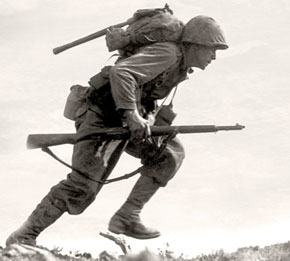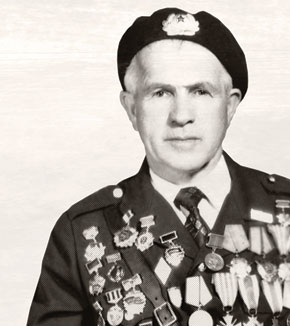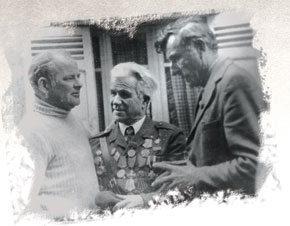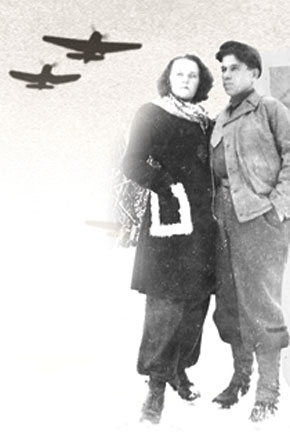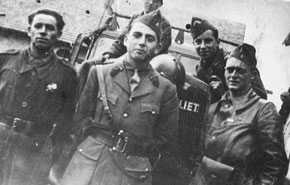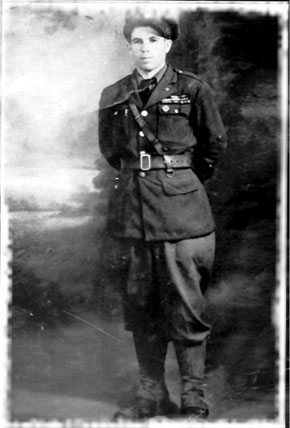This year, 2014, marks the 69th anniversary of the victory over Nazism. Despite the years that separate us from this unprecedented conflict, the spectre of World War II still haunts the world. The memory of this conflict, engraved in the collective subconscious, will continue through future generations.
Occupied by the Red Army from 1920 and annexed by the USSR, Azerbaijan was a strategic point, which led to fierce fighting between the communists and Nazis. At the turn of the 20th century, this oil-rich land, part of the Russian Empire, attracted the attention of many countries, including America, Britain, Germany and France. Producing 11 million tonnes of oil per annum, i.e. 50 per cent of world production, Azerbaijan soon became the favoured target of the Third Reich. Some historians even posit the hypothesis that Hitler attacked the USSR with one sole purpose in mind: to seize Azerbaijan and get his hands on its oil wells.
When the Soviet Union joined the war, the Azerbaijani people rose en masse against the aggressor. In 1941, the population of Azerbaijan was approximately 3.4 million. Between 1941 and 1945, nigh on 400,000 Azerbaijanis, men and women alike, fought Nazism. Nearly 250,000 of them never returned home from the war. Some 20 of the combatants became Soviet heroes of the Great Patriotic War. Some of the heroes are known not only in Azerbaijan but beyond its borders, too: for example, Gen. Hazi Aslanov, a tank commander with distinguished service in many battles including Stalingrad; Mehdi Huseynzade, a partisan in Yugoslavia; Richard Sorge, the most famous 20th century spy of Azerbaijani origin; and Ahmadiyya Jabrayilov, National Hero of France. Ahmadiyya Jabrayilov deserves a special place in that list, as his life story is one of the most astonishing of World War II.
Early life
Born on 22 September 1920 in the village of Okhud near Sheki – an old town in north-west Azerbaijan – Ahmadiyya was the fourth child in a large family. At the time of his birth, the social and political situation in Azerbaijan, especially in his village, was very dangerous. Five months before his birth, in April 1920, the whole country had been occupied by the Red Army. Chaos reigned in the Azerbaijani capital, Baku. The Bolsheviks were persecuting the rich and seizing their fortunes, while the members of the defeated government of the Democratic Republic were fleeing abroad. On top of that, the Armenians were massacring Azerbaijanis under the nose of an indifferent Russian army.
Ahmadiyya’s father was head of a kolkhoz, a type of collective farm that emerged after the October Revolution. An admirer of the Bolshevik regime who received death threats from the regime’s enemies, this young family man bore a burden of responsibility: he had to defend himself, his family and the assets of the kolkhoz. He practically slept dressed and his shotgun hardly ever left his side. His wife and children lived under constant threats of imprisonment and abduction. Little Ahmadiyya lived in this very tense environment for his first six years. His early perceptions of this world must have been of the permanent fear and anxiety that hung like the sword of Damocles over his family.
Heat of battle
After eight years of schooling, he entered the agricultural college in Sheki. Four years later, in 1939, he became an agronomist. The same year, he was called up for compulsory military service like all young men of his age. The new recruit was sent to Ukraine where he was part of the infantry stationed in the town of Lviv. At the start of Operation Barbarossa, the Soviet Union’s Sixth Army, in which the young Ahmadiyya was serving, was partially broken up by German troops before being immediately re-formed at the heart of the southern front. Ahmadiyya was transferred to the 57th Army positioned on the Dniepr to defend the Donbass. In spring 1942, after the victory of the Barvenko-Lozovaya offensive in the Donbass, the Soviet forces, under the command of Marshal Timoshenko, launched a new offensive against the German army. But after a good start at Kharkov, Timoshenko’s army was literally destroyed by German troops, under the command of Gen. Friedrich Paulus, near Izyum Bridge over the Don. More than 240,000 Soviet soldiers were taken prisoner.
Prisoner
Captured, Ahmadiyya was transferred from camp to camp, from Donetsk to Lviv via Rawa Ruska. He ended up in a prison camp in Germany, situated in Frankfurt an der Oder on the Polish border. There were thousands of Soviet prisoners in this immense camp: very few Russians and Slavs, but a lot of Armenians, Azerbaijanis, Georgians, Tatars and Cossacks and, from Central Asia, Turkmen, Uzbeks and Kazakhs. Aware of the hidden hostility between the non-Russian peoples and the Bolshevik regime, Himmler gave the green light to the recruitment of ‘volunteers’ (Freiwilligen) in the Soviet prison camps from the diverse ethnic groups of the USSR, especially from the Caucasus and Central Asia. We just came to fight Stalin and communist Russia. We have nothing against you non-Russians, Nazi propaganda sought to assure the non-Slav Soviet soldiers. As soon as Stalin and his regime are defeated, you will reclaim your independence, as before.
Forced against their will to be Soviet, suffering under Stalin’s dictatorial regime, caught unawares by the great terror of 1936-38, many soldiers from the Caucasus and Central Asia believed this promise of independence for their countries and saw no harm in moving to the side of the adversary. Thus began the formation of the famous Eastern Legions – Ostlegion – composed of Soviet ‘volunteers’. Attached to the Waffen SS, these troops were utilized at the rear of the Russian front. Son of a near fanatical communist and himself a convinced communist, Ahmadiyya Jabrayilov did not believe the promise of the Germans. When he was in Ukraine at the start of the war he witnessed how the Germans treated the Ukrainians, even when the latter welcomed them as liberators. And the cruelty and inhumanity against the Jewish population did not make the Germans trustworthy allies.
Failed escape attempt
Despite ‘correct’ treatment by his jailors and the fine promises of the Third Reich, Ahmadiyya decided to escape and re-join the Red Army. But his first attempt at escape from the prison camp ended in failure. Realising that he would not fight his own people, the Germans decided to send him to do forced labour. In autumn 1942 he was sent to France to work in Vallorey mine, east of the capital, in the Meurthe-et-Moselle Department of the Lorraine region.
Medical ‘experiments’
In this mine prisoners worked in dreadful conditions. Every prisoner had to unload six wagons per day with only one bowl of soup to eat. Wounded and physically weak, Ahmadiyya did not satisfy his torturers for long at the mine. Being dark and circumcised, he was considered Jewish and was declared unsuited for labour and sent to Alsace, to the Natzwiller-Struthof concentration camp, known for its pseudo-scientific ‘experiments’ on the detainees. Governed by SS Hauptsturmführer Josef Kramer, former Dachau guard and assistant to the commandant of Auschwitz, Struthof, like Mauthausen in Austria, was one of the deadliest camps in the Nazi concentration camp system. Prisoners here were divided into two categories: those who wore numbers who came from labour camps and concentration camps and those who wore two large red letters “NN”, meaning Nacht und Nebel (Night and Fog) who were opponents of the Nazi regime from across Europe. Ahmadiyya was in the first category. He wore the number 4,167.
SS Doctor Otto Bickenbach used the prisoners in experiments on the toxicity of hydrogen cyanide salts. Giving off an odour of bitter almonds, hydrogen cyanide is a lethal toxin as it diminishes the quantity of oxygen in the blood. However, there are people who are not susceptible to the odour of almonds and so, for genetic reasons, are not, or only slightly, affected by hydrogen cyanide. The gas is not lethal for such people. They just lose consciousness or in more serious cases fall into a coma. Fortunately, the bearer of No. 4,167 was one of those rare people. After his experiment, the doctor noted only a loss of consciousness.
Death camp escape
The way he survived is incredible. Ahmadiyya tricked his way out of the camp. As he spoke a little German, he made his jailors understand that he was not Jewish but Muslim, not Russian but Caucasian and a Freiwillige who wanted to join the Ostlegion. The trick worked perfectly. In summer 1943, Ahmadiyya was sent to Burloup barracks in Rodez – capital of the Aveyron department in the Midi-Pyrénées – where the Freiwilligen Regiment No. 2, composed of Caucasian ‘volunteers’ and commanded by Oberstleutnant Boehme, was stationed. This legion of 2,000 people was made up of Armenians, Azerbaijanis and Volga Tartars, as well as ‘volunteers’ from Central Asia, whom the local population called “Mongols” because of their slanting eyes.
Buried alive
Rejoining the Ostlegion, Ahmadiyya was sent for treatment to the barracks hospital. Despite the ‘treatment’, Ahmadiyya, who was emaciated and very weak, continued to deteriorate gradually. One day, when he was delirious, his ramblings in his native tongue caught the attention of a cleaning lady. Married to a Turk, this French woman of some 50 years of age spoke and understood Turkish perfectly – a language very close to Azerbaijani. She discreetly engaged the Soviet ‘volunteer’ in conversation and they got to know each other. The woman told him that her name was Janna and that she used to live in Greece with her Turkish husband and children. Her husband had been killed by the Germans during the invasion of Greece and her son was somewhere at the front.
After some exchanges with Ahmadiyya, mutual trust was established, all the more so since this young Azerbaijani reminded Janna of her own son. For his part, Ahmadiyya confessed to her that he was not a ‘volunteer’ at all and that he wanted to escape at any cost and join the local resistance. She promised to help him but first he had to regain his strength and rest quietly. This brave woman began to smuggle him medicines and food, antibiotics and painkillers. Some time later, Ahmadiyya told her that he was able to walk unaided and ready to make his escape. But leaving the Burloup barracks was not easy, if not impossible, without outside accomplices. After thinking for a few days, Janna came back with a proposal, which left the young man speechless. He would have to swallow a powerful sedative based on barbiturates in order to faint. Janna would report his death and arrange his ‘burial’. Then Janna’s accomplices would disinter him and take him to a safe place.
It was no sooner said than done. Janna reported the ‘death’ of a ‘volunteer’ to her superiors and arranged a ‘dignified’ burial since the ‘volunteer’ reminded her of her son. Once authorisation was given, Ahmadiyya’s body, almost lifeless because of the barbiturate, was put in a coffin and buried in the cemetery in the presence of several Volga Tartar ‘volunteers’. As soon as the pallbearers left the cemetery, Janna’s accomplices dug up the coffin and freed Ahmadiyya who was still unconscious. He ‘came back to life’ in Janna’s house.
Resistance fighter
This is when Ahmadiyya’s new life began. Freed and recommended by Janna to the maquis in the region, he did not earn the trust of the irregulars straightaway. His past in the Ostlegion and the fact that he was communist left the resistance fighters undecided. The language barrier was quite important, too, but Janna was his guarantor and engaged her young daughter and one of her friends to teach him French.
Several months later, Ahmadiyya was received into the Veny resistance, commanded by Gen. Vincent, alias Veny, and was involved in sabotage operations, the distribution of pamphlets and the receipt of parachute drops from Great Britain. Called Akmed Michel by the resistance fighters, Ahmadiyya took part in ever more dangerous operations in different resistance groups. Often disguised as a woman, he blew up restaurants and cafes where German officers used to party. Dressed in the uniform of the ‘volunteers’, he entered goods trains to lay explosives, blew up bridges and railway lines in order to prevent the advance of German troops. Nicknamed Kharko, Russian Akmed and the Brave by the different maquis, Akmed Michel soon became the Germans’ bête noir in the Lot-et-Garonne, Haute-Garonne, Tarn-et-Garonne and Aveyron departments. Eventually, the regional Gestapo put a price of 10,000 Marks on his head, offering it to anyone who could eliminate Kharko. A man-hunt began. He was hunted by the Germans, Pétain’s police, collaborators and even by the Soviet ‘volunteers’ working for the Germans. Careful, his commanders often changed his location and maquis in order to shake off his detractors. He circulated among the towns of Rodez, Albi, Montauban, Agen, Capdenac, Carmaux and Bordeaux, changing maquis and aliases.
Liberation
In spring 1944, he was welcomed into the maquis of Cabertat de Tarn et Garonne, commanded by Capt. Gaston Delplanque alias Dumas. Here, alongside Lt Louis Lasbareilles alias Pet-Sec, former commander of the maquis Groupe Fracasse, René Chambard alias Négrita, Georges Jacquot alias Marsouin, Jaques Teyssières alias Volter and Noel Duplan alias Nil, he took part in the liberation of the towns of Montauban, Albi and Rodez.
On 16 September 1944, Akmed Michel was presented to Gen. Charles de Gaulle in person when he visited newly liberated Toulouse. Akmed Michel never forgot this meeting, nor did Gen. de Gaulle.
After the liberation of the Midi-Pyrénées, determined to fight on to the total liberation of France, Akmed Michel and his friends joined the 3rd Hussars Regiment. Together, they left the Midi-Pyrénées for Alsace. Under the command of Gen. De Lattre de Tassigny, attached to the 2nd Armoured Division that came from Normandy, Akmed Michel took part in early October 1944 in the battle of the Vosges, then on 19 November, they liberated Mulhouse and Belfort. But he did not go on to the total liberation of Alsace with his comrades. In March 1945, his captain, Louis Lasbareilles alias Pet-Sec, received the order to exclude Akmed Michel from the 3rd Hussars Regiment. The reason? The treaty signed by Stalin and Charles de Gaulle four months earlier.
Rejection
In November 1944, Gen. de Gaulle decided to meet Stalin. The main objective of his trip was the signing of a treaty on Franco-Soviet cooperation. The French delegation arrived in Baku on 26 November 1944. After one night in the Azerbaijani capital, during which the general attended the national opera in Baku, the delegation went to Stalingrad. By 2 December 1944 Gen. de Gaulle was in Moscow and, eight days later, he and Stalin signed the Franco-Soviet pact. The pact included the provision inter alia of the repatriation of French prisoners to France, and Stalin demanded for his part the repatriation of all Soviet citizens to their country. Knowing full well that Stalin considered the capture or surrender of his soldiers as an act of treason, Gen. de Gaulle was obliged to give approval. Thus, following this disastrous and shameful French policy, thousands of people like Akmed Michel, who had fought with the French against the Germans, were obliged to return to the USSR.
The friends of Akmed Michel, who were well aware of Stalin’s intentions towards former Soviet prisoners, did their best to keep him in France, but in this impossible situation their room to manoeuvre was limited. Despairing, Louis Lasbareilles, his friend and captain, even tried to get him into the Foreign Legion, but this attempt did not work either. For months, Akmed Michel lived in Paris and Burgundy; his friends put him up to hide him from the NKVD agents that Stalin sent in their thousands to France. These agents combed through French towns and countryside in their search for Soviet citizens in order to take them back to the USSR. But Akmed Michel could not live in his friends’ homes for ever. He had no resources, no money, no fixed abode, and despite the great need for a workforce in France, all his applications for work were turned down. Finally, at the end of 1945, after nine months of moving from pillar to post, this Francophile, frustrated and humiliated by the attitude of the country for which he had fought and which now rejected him, returned to the USSR.
Branded a traitor
On their return, more than 80 per cent of former Soviet prisoners were condemned to forced labour in Siberia and 20 per cent were tortured in prison. Akmed Michel was not spared. He was arrested by the NKVD (forerunner of the KGB) and for years in his home country, in his home town, he was tortured physically and psychologically by the Soviet political police. The local NKVD agents, depending on their mood and how far they were trying to climb the greasy pole, would beat him unconscious, tear out his teeth and fingernails; they even cut out portions of his flesh. He said that he suffered worse torture than he had known in the Nazi concentration and labour camps. As he was considered a ‘traitor’ by his homeland, no-one dared to say hello to him, no-one dared to talk to him, everyone avoided him. He had no work and was obliged to hunt to feed his family. His wife and children, too, were badly treated and considered the ‘family of a traitor’. He was then obliged to live in the forest, to hide in cemeteries and sleep in old graves to escape his torturers.
National Hero of France
Salvation came in 1966 when Gen. Charles de Gaulle made his second official visit to the USSR. The French president’s communication service sent a list of the names of people that Charles de Gaulle would like to meet in Moscow. It included one Akmed Michel. The Soviet secret service, with the help of the Ministry of Foreign Affairs, searched for the famous Akmed Michel and tracked him down to Azerbaijan, to the town of Sheki, under the name Ahmadiyya Jabrayilov. Summoned urgently to Moscow, he was in the front row among the veterans ‘honoured’ by their homeland, who welcomed the president of the French Republic.
It was after the meeting with Charles de Gaulle that recognition and gratitude embraced Ahmadiyya Jabrayilov. Overnight he became the most famous person in the country. He was the star of TV and radio programmes; his bravery and heroism were the subject of plays and documentary films, novels and short stories. Even better, he was permitted to meet his maquis friends in France and together they visited the towns of Rodez, Montauban and Albi – towns where he fought for the liberty of France – the country that he would always call his “second homeland”. As a mark of gratitude, the French government awarded him the title National Hero of France. He was presented with the Medal of Honour for acts of bravery and the Medal for the Wounded. Ahmadiyya Jabrayilov held the Croix de Guerre (Cross of War) 1939-45, the Cross of Military Valour and the Medal of the French Resistance. In 1994, during his last visit to France, Akmed Michel was presented with the medal of a chevalier of the Légion d’honneur.
Social turmoil
The last six years of his life, like the first six years of his childhood, were spent in a very tense social and political atmosphere. From 1988, like all the Azerbaijani people, he suffered new trials in his life: the collapse of the USSR, the invasion of Azerbaijani territory by the Armenians, the massacre of Azerbaijanis in their own land by Armenian forces before an indifferent Red Army. The last six years of his life, Ahmadiyya Jabrayilov spent like the first six, with fear and anxiety hanging over him like a sword of Damocles. Moreover, in December 1990, his eldest son Mikael, a local policeman, was killed by Armenian troops in the Karabakh war.
On the evening of 3 October 1994, 13 days after his 74th birthday, Ahmadiyya Jabrayilov was knocked down by a car as he crossed the street in the town of Sheki. He was taken to the local hospital with minor injuries, which were not considered critical. However, six days later, on 9 October, he died in hospital in obscure circumstances. There was no autopsy to determine the causes of death. On 10 October, he was buried in the cemetery of his home village at his son’s side. Four years later, in 1998, France posthumously awarded him the National Diploma of Gratitude for his participation in fighting for the liberation of France.
Two bronze statues, honouring father and son, now stand side-by-side in the old cemetery: one for Mikael Jabrayilov, National Hero of Azerbaijan, the other for his father Ahmadiyya Jabrayilov, National Hero of France.
About the author: Shain Sinaria is a writer, dramatist and film-maker, based in Paris. The author of Le procès d’Adam et Ève (The Trial of Adam and Eve) and Chronique d’un malheur annoncé (Chronicle of a Misfortune), he also translates Azerbaijani authors into French. His full biography of Ahmadiyya Jabrayilov is due to be published in early 2015 to mark the 70th anniversary of the liberation of France and the victory over Nazism.
